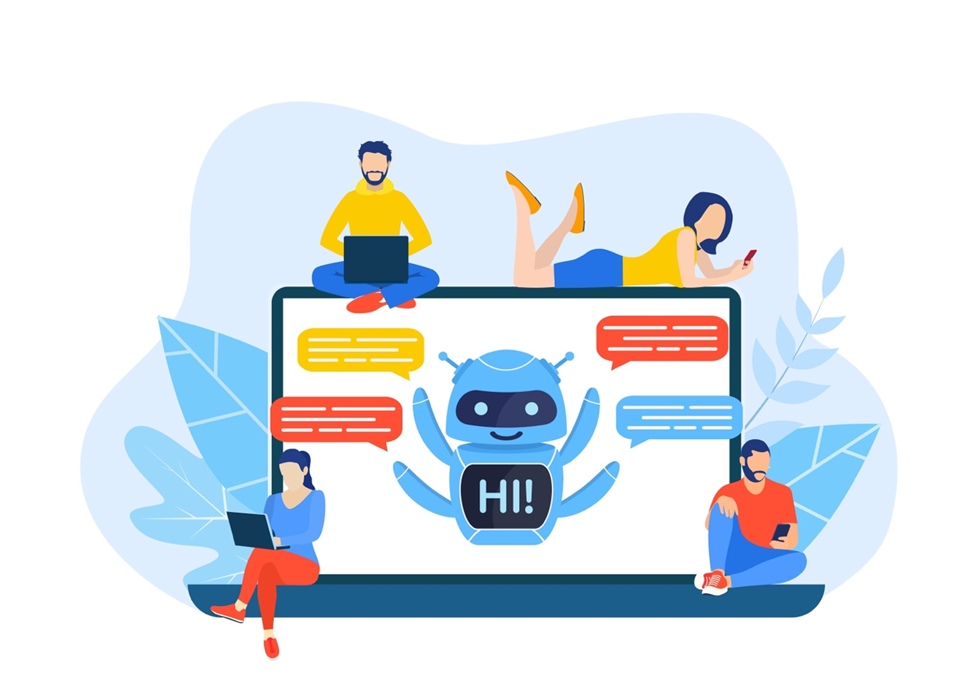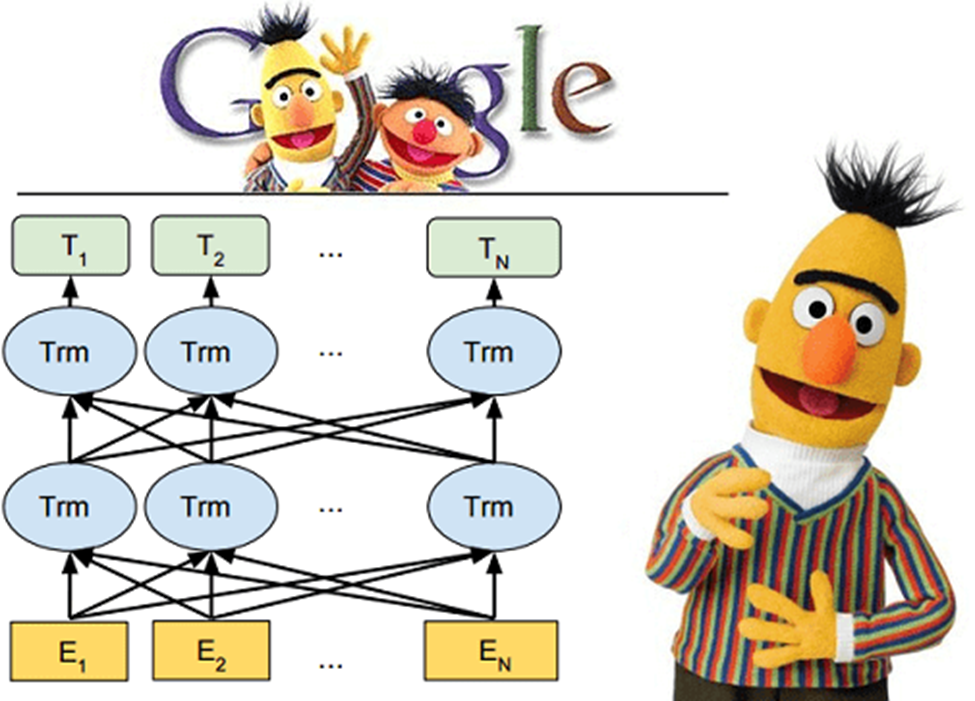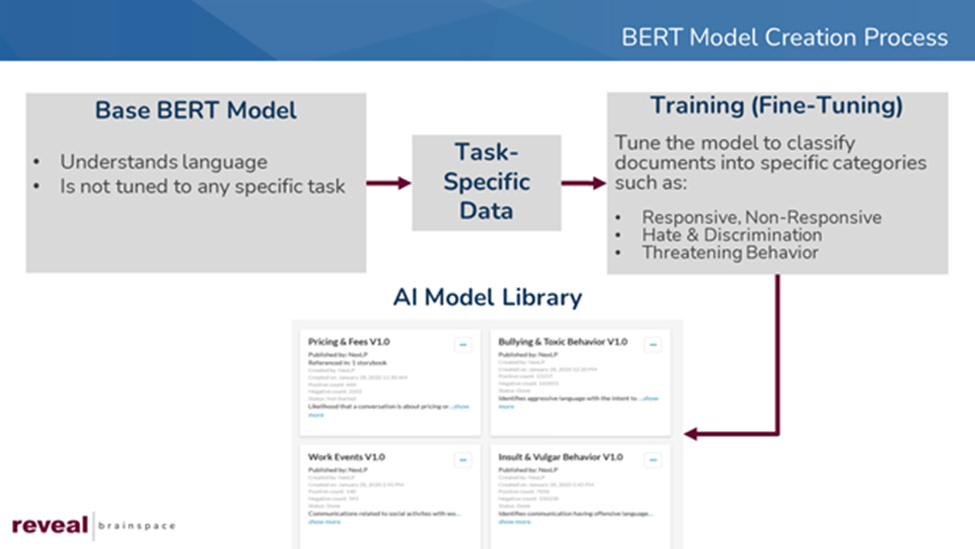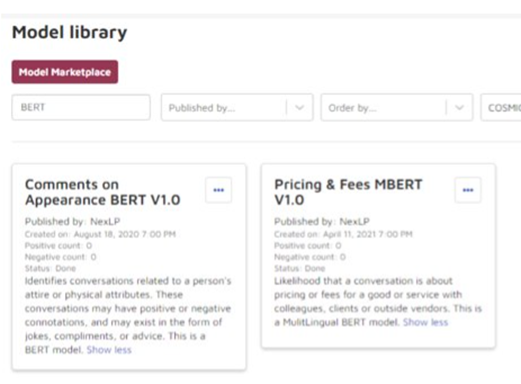AI-powered Large Language Models: The Future of eDiscovery is Now
ChatGPT and the company that developed it, OpenAI, are on a tear. The rate of user adoption puts even social media behemoths like TikTok and Facebook to shame. The Chatbot AI platform has gained more than 100 million users within the first two months of its launch. And has more than 13 million daily visitors as of 2023. and there is powerful tech behind all this hype.
ChatGPT uses GPT-3 technology which is part of a category of AI known as Large Language Models. And it is not their first rodeo shaping up the practice of law! The underlying tech of large language models enables ChatGPT to create text that feels human. But this is just the latest in an evolution in LLM development to supercharge legal tech.
LLMs like BERT and MBERT are supercharging search, machine translation and even image classification today at Reveal. Building the foundation for the current AI revolution we find ourselves in today. The evolution of LLMs has helped Reveal empower electronic discovery professionals with better, faster, smarter AI-powered solutions.
In this blog post, we will dig into the AI known as LLM and how it's revolutionizing the eDiscovery process for lawyers everywhere. We'll also take a playful and irreverent look at how Reveal is shaking up the legal technology world with their innovative use of LLMs. As well as what the LLM powered future of legal tech might look like.
So, sit back, grab a cup of coffee, and get ready to discover how LLMS are taking legal tech to the next level.

What are Large Language Models, and Why Should eDiscovery Care?
Large language processing was a breakthrough in artificial intelligence (AI). LLMs build intelligent systems with a richer understanding of language than ever before. Large pre-trained Transformer language models, or simply LLMs, vastly extend the capabilities of what systems can do with text.
Large Language Model is basically a fancy way of saying a super-smart AI technology that can understand and generate human language leveraging vast text-based data sets. Think of it like a machine learning algorithm version of Sherlock Holmes. Rather than starting at zero each time, the LLMs can build models that are informed by a vast wealth of human-generated content.
And this is lightyears beyond "spellcheck" or the editor “Hemingway” that I will use to edit this blog. These things are seriously powerful. And they're changing the game in fields like eDiscovery, where lawyers are facing a tsunami of data in their search for evidence.

Transformers, Not Just Saturday Morning Cartoons
There are a variety of LLM AI tools and models available today. Each with varying architectures and capabilities. ChatGPT is part of a subgroup of LLMs known as transformer models. And no these are not like that robot from Saturday morning cartoons growing up.
Transformer models are a type of neural network architecture that was first introduced in 2017. LLMs are used in natural language processing tasks. These include language modeling, machine translation, and text classification. They are known for their ability to capture long-range dependencies and have become the dominant architecture for large-scale language modeling.
Shortly after the first paper was written on transformer models, Google introduced a new open-source language representation model they called “BERT.” BERT (Bidirectional Encoder Representations from Transformers) is a pre-trained natural language processing (NLP) model that leverages a deep neural network to represent the meaning and context of text. The multilingual version MBERT was also developed and trained in 104 languages. MBERT does more than translate, it understands how content in different languages is semantically related.

What is BERT And Why Should I Care?
As a language model, BERT analyzes text and lots of it. It also analyzes the text backwards and forwards. From this analysis, BERT or MBERT predicts any word in a sentence or body of text. This is known as a Masked Language model approach.
In a recent article on Bert and MBERT use by reveal George Socha described Bert as follows:
BERT is a form of deep learning natural language processing that can jump-start your review. It does this via a more nuanced “understanding” of text than is achievable with traditional machine learning techniques. BERT arrives at this understanding by looking beyond individual words to those words’ context. MBERT takes BERT one critical step farther. MBERT is the multilingual version of BERT, trained to work with 104 languages.
BERT marked a huge leap forward in the accuracy of Language models. “Previous models have been stuck at 65% accuracy for decades, but now a standard BERT based (LLM) model is able to do this in a reasonable time (milliseconds) with an 85% - 90% accuracy.” According to a recent Forbes article.

Bert in the Wild
The use of LLMS like the use of AI generally is widespread. Use cases of BERT and MBERT technology run the gamut in our personal and professional lives. These LLMs are streamlining decision making in film, customer service and social media to name a few.
- BERT the Movie Critic: Movie studios can analyze large amounts of text data such as movie reviews, social media posts, and news articles to predict how well a movie will perform at the box office. Studios invest hundreds of millions in developing films and no one them to flop!
- mBERT the Polyglot: MBERT improves the accuracy and quality of translations. MBERT understands the relationship between words and sentences in both the source and target languages. BERT considers the context and meaning of the words and phrases. This helps it to produce more accurate and nuanced translations.
- BERT at your Service: BERT is helping to power chatbots focused on customer service. For example, a customer may ask a question about a product, and the BERT-powered chatbot understands the customer's intent and provide an appropriate response.
- BERT the Assistant: BERT is also being used to power virtual assistants like Amazon Alexa. BERT helps these virtual assistants to provide more helpful and personalized responses to users. BERT helps ALEXA understand the nuances of natural language. One cool example: a user asks about the weather; the virtual assistant can use BERT to understand the user's location and provide a localized weather forecast.
- mBERT all the Feels: mBERT improves sentiment analysis in social media. The LLM can accurately classifying the sentiment of social media posts’ text in different languages. This is particularly important in social media monitoring of platforms like Twitter and Facebook which are used by people around the world to express their opinions and feelings.
- BERT Fakenews Detective: Fakenews can have a big impact. BERT can identify articles based on false information, such as conspiracy theories or rumors. It can also be used to identify articles that are deliberately misleading or Click-bait.
- mBERT Shopping Assistant: E-commerce sites can improve their search algorithms with BERT. By incorporating natural language understanding and context into the search process.

Reveal and BERT a Match Made in eDiscovery Heaven.
So, what does that mean for me and my legal team?
Picture this: you're in the middle of a complex legal case. Buried under mountains of documents and struggling to find that one crucial piece of evidence that could make or break your case. The clock is ticking, your eyes are glazing over, and your brain feels like it's about to explode. But fear not, legal warriors! There's a secret weapon that can help you conquer this daunting task.
Enter Reveal, the eDiscovery company that's been using AI-powered LLMs including BERT for years to help lawyers cut through the noise and find what they're looking for with speed and precision. While Chat GPT may be the new kid on the block in the LLM universe, the power of LLMs has been well-established. And Reveal is at the forefront of this cutting-edge technology.
At Reveal we use BERT and MBERT to build the following game-changing solutions and workflows:
- mBERT Powered Text Classification: Reveal uses mBERT to sort through large volumes of multilingual text. By using mBERT to analyze and classify this text data, we can automatically sort it into relevant categories. Categories can include privileged documents, confidential communications, or key evidence.
- Bespoke Bert AI Models: We have AI models built with mBERT technology. Building BERT-powered models can be more time intensive, but the results are powerful. They find responsive information quickly than legacy models.
- MBERT Powered AI Model Library: You don’t need to wait for us to create new BERT-based AI models. If you use our platform, you can build AI models with BERT yourself, and add those models to your AI Model Library. LLMS are streamlining everything from what films we watch to.

Three examples of BERT/MBERT models we have built are:
- Bullying & Toxic Behavior: Identifies aggressive language with the intent to cause someone mental harm or shame.
- Hate & Discrimination: Identifies communications of animosity or disparagement toward an individual or a group. This may be due to their race, color, national origin, sex, disability, religion, or sexual orientation.
- Threatening Behavior: Identifies conversations with offensive language and strong intent to inflict physical or mental harm to someone else.
- MBERT Language translation: Reveals can do language translation leveraging the 104 languages MBERT was trained with. Saving time and money in uncovering foreign language ad understanding the context of their use.
- BERT Computer Vision: LLM assists in image labeling and identification, supercharging our image search.
AI in eDiscovery continues to evolve from connecting the dots and uncovering linguistic patters, as BERT and MBERT do today to generative solutions like ChatGPT. The lessons learned from validating and incorporating LLMs like BERT are helping equip Reveal.
The AI and LLM Future of eDiscovery
AI technology is here to stay in eDiscovery. As we delve deeper into the vast and complex universe of electronic data, one thing is clear: the future of eDiscovery is now. With LLMs, we can navigate the treacherous terrain of digital information and unearth hidden gems of knowledge with ease.
These intelligent models are not just machines, they are our companions on this great journey through the cosmos of data. With their unparalleled ability to understand and interpret language, they help us to explore uncharted territories, uncover new insights, and boldly go where no lawyer has gone before.
Learn more about how you can use BERT and LLMS
Want to learn more about how your law firm or service providers can use BERT and BERT-powered AI models to uncover relevant documents? Curious how Reveal uses AI as an integral part of its AI-powered end-to-end legal document review platform – contact us to learn more.

